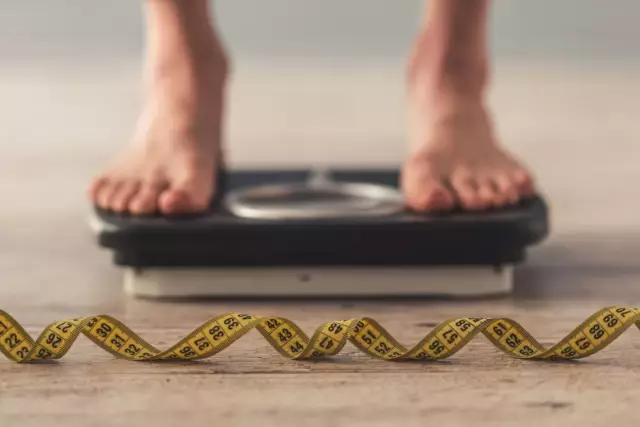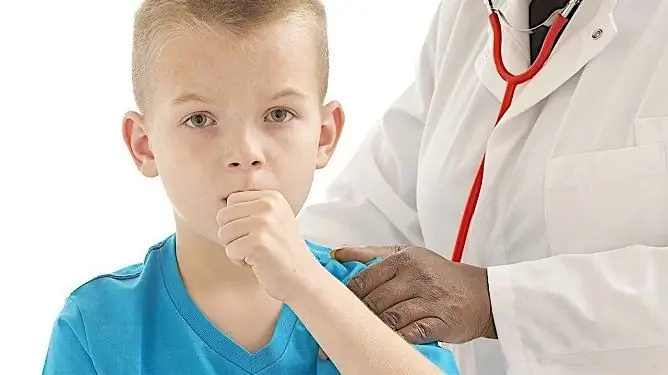- Author Rachel Wainwright [email protected].
- Public 2023-12-15 07:39.
- Last modified 2025-11-02 20:14.
How to cure sinusitis in adults: basic methods, reviews
The content of the article:
-
Drug treatment of sinusitis in adults
- How to get rid of sinusitis with topical preparations
- Oral medicines
-
How to cure sinusitis without puncture and surgery
- YAMIK catheter
- Balloon sinusoplasty
- Laser coagulation
-
Surgical treatment of sinusitis
- Puncture of the maxillary sinus
- Sinusitis
- How to cure sinusitis with folk remedies
- Video
Sinusitis is a pathological process that affects the mucous membrane of the maxillary sinuses. To understand how to cure sinusitis, one should understand its etiology and pathogenesis. The disease is polyetiological, that is, it can have several causes. In most cases, the disease develops against the background of a bacterial infection.

To prescribe therapy for sinusitis, you should consult an otolaryngologist
The disease is characterized by swelling of the nasal mucosa and mucus hypersecretion. As a result, the outflow of secretion is disrupted, which leads to difficulty in nasal breathing. To normalize external respiration, the contents of the nasal sinuses are provided with an outflow. Etiotropic treatment consists in the appointment of antibacterial agents. In addition, in the course of conservative therapy, anti-inflammatory and vasoconstrictor drugs are used.
Severe and advanced forms of the disease require surgical treatment. For this, invasive and minimally invasive methods of therapy are used. With a high risk of pus breakthrough into the cranial cavity or the ineffectiveness of conservative treatment, a diagnostic and diagnostic sinus puncture is performed. Minimally invasive techniques include laser coagulation, balloon sinusoplasty and flushing with a YAMIK catheter.
Drug treatment of sinusitis in adults
How to get rid of sinusitis with topical preparations
The main groups of medicines for topical use:
- Decongestants (vasoconstrictors). Preparations based on phenylephrine (Nazol Baby, Nazol Kids), naphazoline (Naphtizin, Sanorin) and tetrizoline (Tizin) have a short duration of action (up to 6 hours). The drugs based on xylometazoline (Galazolin, Snoop, Otrivin, Xymelin, Nosolin), tramazolin (Lazolvan Rino) have an average duration of action (6-8 hours). Sprays and drops with oxymetazoline (Nazivin, Knoxprey, Oksifrin, Nazol) work the longest. Oxymetazoline also has a proven antiviral effect. Decongestants can be used in a course of up to 14 days. With longer use, there is a risk of atrophy of the nasal mucosa. The mechanism of action of these agents is the narrowing of the capillaries by binding to adrenergic receptors in the nose.
- Antiseptics and antibiotics. The funds are used for bacterial infection. Framycetin-based preparations, for example, Isofra nasal spray, have a good effect. It is prescribed for 7-14 days. Sanitation of the nasal cavity can also be carried out with a solution of Miramistin or Furacilin. To prepare a Furacilin solution, you should grind 2 tablets and fill them with warm water. In some cases, antibiotic ointments are prescribed (Tetracycline, Syntomycin).
- Antiviral and immunostimulating agents. Alfarona, Grippferon, Ingaron are interferon-based drugs used for intranasal administration. They indirectly affect the infection by stimulating the immune system. IRS-19 is a complex preparation from bacterial lysates. It enhances specific and non-specific immunity.
- Glucocorticosteroids (GCS) and antihistamines. Avamis, Nasonex, Fliksonase contain GCS (mometasone furoate, fluticasone), which relieve edema and hyperemia. Allergodil and Azelastine are antihistamines. The listed groups of drugs are mainly prescribed for sinusitis with allergic etiology.
- Phytopreparations. The plant components that make up Pinosol have an anti-inflammatory and moisturizing effect. It is forbidden to use phytodrops in case of a disease of allergic etiology. Sinuforte is made from cyclamen juice. It reflexively acts on the trigeminal nerve, increasing the secretion of mucus. In addition, the active substances of the spray dilute the secretion, facilitating its outflow from the maxillary sinuses.
- Combined drugs. The most commonly prescribed drugs include: Polydex (Neomycin, Polymyxin B, Dexamethasone), Rinofluimucil (ACC, Tuaminogheptan), Vibrocil (Dimentinden, Phenylephrine). Their therapeutic effect is due to the properties of the constituent components.
Saline solutions are used to mechanically cleanse the nasal cavity from mucus and microbial particles by washing. They are divided into hypo- and hypertensive. Their main difference is the percentage of salts. In addition to pharmaceutical preparations (Aqua Maris, Humer, Pshik, Aqua-spray), a solution of NaCl (table salt) is also used for rinsing the nose. The minerals in these products soften the nasal mucosa and cleanse it of pathogens.
Oral medicines
Acute sinusitis is characterized by fever, profuse mucopurulent discharge from the nose, as well as other symptoms of general intoxication. To alleviate the condition, various groups of drugs are used.
To reduce fever and relieve pain, non-steroidal anti-inflammatory drugs are prescribed. Paracetamol has a pronounced antipyretic and analgesic effect. Ibuprofen and Naproxen can also be used.
Antihistamines are used to relieve swelling. They block receptors for histamine, preventing its biological effects. There are two generations of antihistamines. The first includes Diphenhydramine, Chloropyramine (Suprastin), Khifenadine and others. They have a pronounced anti-allergic effect, but they cause drowsiness. The second generation includes Cetirizine (Cetrin), Loratadine, Levocetirizine, Desloratadine. They can be used for a long time, do not sedate and rarely cause side effects.
Mucolytics are prescribed to improve the rheological properties of mucus. These include Libeksin, ACC, Mukolvan and others. Usually they are used for diseases of the bronchi and lungs. However, they are also effective for the pathology of the maxillary sinuses.
Etiotropic therapy involves the appointment of antibacterial drugs. They act directly on the cause of the disease. This group of drugs is effective only for purulent forms of the disease.
Before prescribing antibiotics, sinus discharge is cultured, as well as sensitivity tests. For empirical (initial) therapy, broad-spectrum drugs are prescribed.
Antibacterial drugs of choice for sinusitis: Ampicillin, Azithromycin, Cefixime, Amoxicillin + clavulanic acid (Augmentin, Amokisklav), fluoroquinolones (used for sinusitis caused by gram-negative flora).
The most effective therapy can be prescribed by an otolaryngologist. The choice of antibiotic depends on the nature of the sown flora and individual tolerance.
How to cure sinusitis without puncture and surgery
Minimally invasive treatment techniques are used to stimulate the outflow of fluid from the maxillary sinuses. Their advantage is high efficiency and minimal risk of complications. Surgical removal of the contents of the sinus is carried out according to strict indications.
YAMIK catheter
Before starting the procedure, a superficial anesthesia of the nasal mucosa is performed. A catheter with a balloon at the end is inserted into the nostril and out into the nasopharynx. The second balloon is located in the middle of the catheter. It stays directly near the nostril. The balloons are inflated with air to seal the nasal cavity.

Sinusitis treatment with YAMIK sinus catheter is suitable for children and pregnant women
The YAMIK catheter has two syringe lumens. A syringe is connected to the first for injecting air, to the second - for the introduction of antiseptic solutions.
The procedure has established itself as an effective and safe method of treatment. It is suitable for children and pregnant women.
Balloon sinusoplasty
Balloon sinusoplasty is a minimally invasive method of treatment carried out using a special balloon inserted into the fistula of the nasal sinuses. This procedure is an alternative to puncture and sinusitis. The essence of the method is to expand the excretory fistula of the maxillary sinus.
The intervention is performed under endoscopic control with local anesthesia. A conductor is passed into the sinus through which the balloon is installed. The latter is filled with liquid, which helps to open the lumen for the evacuation of pus.
Laser coagulation
Laser coagulation is an advanced method for treating sinusitis. Today, two types of procedures are performed: low-intensity and high-intensity laser therapy.

Laser coagulation is one of the most effective treatments for sinusitis.
Low-intensity laser therapy allows you to relieve swelling, inflammation, and also helps to mechanically cleanse the sinuses. The beam is brought directly to the site of injury.
Using a high-intensity laser, nasal vessels are coagulated. The advantage of this method is its non-invasiveness and low risk of infection. The laser quickly coagulates the vessel, preventing it from bleeding.
Surgical treatment of sinusitis
Puncture of the maxillary sinus
Despite a number of complications, puncture of the maxillary sinus is one of the most effective methods of treating sinusitis. The procedure has not only therapeutic but also diagnostic value. It allows you to assess the patency of the sinus fistula, as well as to establish the nature of the pathological process.

If conservative methods of treatment are ineffective, a puncture of the maxillary sinus can be prescribed.
Indications for the operation:
- ineffectiveness of conservative methods of therapy;
- obstruction of the anastomosis of the maxillary sinus;
- severe condition accompanied by intense headaches and / or facial pains;
- the presence of a horizontal liquid level on CT (computed tomography).
It is forbidden to perform an operation for developmental anomalies and aplasia of the sinuses. Also contraindications include diabetes mellitus, arterial hypertension, heart failure in the phase of decompensation.
The procedure is quite simple. Before the introduction of the needle, the nasal cavity is cleaned and anesthetized with a solution of lidocaine (10%). The puncture is performed with a Kulikovsky needle, which is directed to the inferior turbinate. In this place, the wall of the maxillary sinus is most pliable. After a puncture, the sinus is washed with antiseptic solutions.
Puncture complications include bleeding and air embolism.
Sinusitis
Sinusitis is a surgical method for treating sinusitis, which involves opening the sinus followed by evacuation of its contents. Most often prescribed for odontogenic sinusitis.
The method is highly traumatic and is used only in extreme cases.
How to cure sinusitis with folk remedies
Treatment of sinusitis with folk remedies has no proven clinical effect. However, alternative medicine can be an adjunct to mainstream therapy. Reviews of the treatment of sinusitis by folk methods are mainly positive. But before using phytotherapeutic drugs, you should consult with your doctor and make sure there are no allergies. Sometimes herbal medicine can cure the disease without antibiotics and punctures.

One of the herbal remedies is thuja oil
How to cure sinusitis at home:
- Thuja oil has antiseptic and immunostimulating properties. Phytotherapists recommend instilling 2-3 drops of the drug in each nostril, after rinsing the nose with saline. The duration of treatment is 4-6 weeks.
- Cyclamen juice has a reflex effect. After getting on the nasal mucosa, it stimulates the natural cleansing of the nasal cavity. The irritant effect on the trigeminal nerve causes a reflex sneezing. With regular use of the drug, the sinuses are completely sanitized.
- Propolis has antiseptic and wound healing properties. Propolis tincture is mixed with any vegetable oil (1: 1). Instill 2-3 drops in each nostril 2 times a day.
Sinusitis is a disease that requires an integrated and qualified approach. The prognosis of the disease depends on the choice of therapy tactics. To be cured of pathology forever, you need to see a doctor in time. How to treat sinusitis in adults and children, the otolaryngologist will tell you.
Video
We offer for viewing a video on the topic of the article.

Yulia Evtekhova Therapist About the author
Education: Dnepropetrovsk State Medical Academy.
Work experience: Nurse of the Rheumatology Department of Dnepropetrovsk City Hospital No. 11.
Found a mistake in the text? Select it and press Ctrl + Enter.






